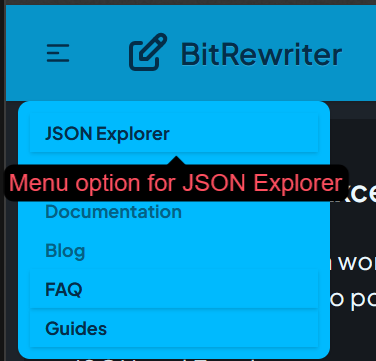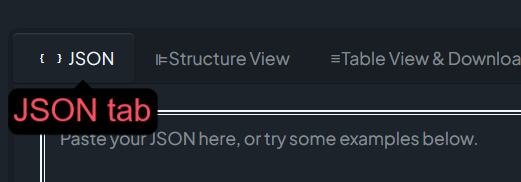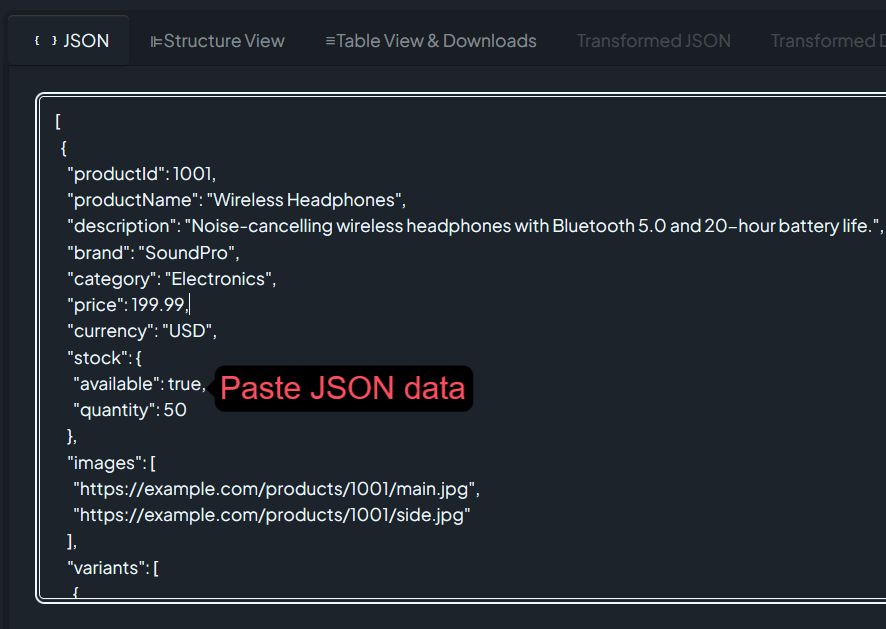Convert JSON to CSV
Efficiently handling data formats is essential. One common challenge many face is converting JSON to CSV.
Whether you’re a data analyst looking to streamline your workflows or a business owner wanting to make sense of your data, our tools will help you effortlessly convert JSON to CSV.
Dive in and discover how to harness your data’s potential today!
If you are interested in converting data from multiple tables into a collection of CSV files (zipped into a single .zip file), see: How to convert a full JSON file to a zipped collection of CSV files.
Alternatively, our .xlsx format supports - in a single file - one table per sheet, or all tables on a single sheet.
This step-by-step guide is designed to help you effortlessly transform any individual JSON table into a single CSV file for opening in Excel™, Sheets™, or your own applications.
See the following for more info on what exactly we mean by a JSON table: What is a JSON table
In short:
One table per 'type' of object. One table row for each object instance. One column for each value property.
If a JSON object contains another object, the corresponding tables have a join between the former parent and the latter child tables' rows.
-
Step-by-Step
-
Visit our JSON Explorer tool (free to use).

Menu option for JSON Explorer (PC/Desktop/Tablet) 
Menu option for JSON Explorer (Mobile)
-
Go to the JSON tab, if not already selected.The JSON tab is where you provide your JSON data. Other tabs work on the data provided here.

JSON tab in JSON Explorer
-
From JSON tab, paste in your JSON.Paste your JSON data here. If the data is not valid JSON, it will all be outlined in red, and will not update any other tabs.

JSON tab with data in JSON Explorer
-
Move to the Downloads & Table View tab.Once you have pasted in valid JSON data, switch to the Downloads & Table View tab.

Downloads & Table View tab in JSON Explorer
-
Navigate down to the table data if interest, click that table's "CSV (.csv)" button.
CSV Download button
-
Review your download.
CSV file open in Excel
-
-
Common Issues and Troubleshooting Tips
Despite the straightforward nature of our JSON to CSV conversion, you may encounter some common issues. Understanding these potential problems and knowing how to troubleshoot them can save you time and frustration.
- One of the most frequent challenges is dealing with nested JSON structures: JSON data often contains nested objects and arrays. There are a number of approaches to dealing with this. Our CSV transformer exports nested structures into distinct tables with a common tabular format. Unlike our competitors, our approach preserves your data in a tabular format with a fixed number of columns. The alternative approaches taken by other tools is to use confusing column naming conventions incorporating property names with numeric indexes that leads to variable number of columns.
- In addition, we will support more advanced manipulation option for flattening JSON structures into more easily handled structures.
- Data type mismatches can also pose problems during conversion. JSON natively supports a few basic data types, including strings, numbers, and booleans. But CSV stores everything as a string without any typing at all. It is up to your applications and processes to understand your data. Our tool can help you validate data. Ensuring proper data type conversion is crucial for maintaining data integrity. You may need to specify data types explicitly during conversion or perform post-conversion data cleansing and validation to correct any mismatches.
- Also, sometimes the basic JSON types can be misused, e.g. storing numbers or booleans within a string. Our tool helps you spot such issues, with conversions coming soon that will help.
- Improved support for validation, cleaning, and conversion of JSON data is coming soon.
- By being aware of these common issues and having troubleshooting strategies in place, you can streamline the JSON to CSV conversion process and ensure accurate and reliable results.
-
Understanding JSON: What You Need to Know
- JSON (JavaScript Object Notation) is a lightweight data interchange format that has become very popular due to its simplicity and ease of use.
- It is fully text-based and designed to be both human-readable and machine-readable, making it an ideal choice for transmitting data between servers and clients.
- JSON structures data in a collection of name/value pairs and arrays, allowing for a flexible representation of complex data sets.
- Understanding the structure of JSON is crucial for effectively working with and converting it into other formats, such as Excel™, CSV or other tabular formats that are non-hierarchical.
- JSON objects are enclosed in curly braces {}, with each key-value pair separated by a comma. Keys are strings, and values can be strings, numbers, booleans, arrays, or other objects.
- JSON object keys can represent a fixed set of properties, or keys into dictionaries/maps.
- Arrays are simply ordered lists of values or other objects enclosed in square brackets [].
- One of the significant advantages of JSON is its compatibility with many programming languages, including JavaScript, Python, and Java. This universal support means JSON can be easily generated and parsed by various systems.
-
Why Convert JSON to CSV?
- Converting JSON to CSV opens up a world of possibilities for data analysis and visualization if imported into Excel™ for example, while also allowing straightforward integration with other systems.
- While JSON is excellent for data interchange, CSV allows import into Excel™ which is renowned for its powerful analytical tools and user-friendly interface. Excel's capabilities, such as pivot tables, charts, and formulas, make it an indispensable tool for anyone looking to analyze large data sets efficiently. By converting JSON to CSV, you can leverage these features to gain deeper insights into your data.
- CSV may be the best option when you need both the power of Excel™ as well as the ability to import into other applications, processes, and integrations where Excel's native format (.xlsx) is not available or overly complex.
- CSV's widespread use in various industries is another compelling reason to convert JSON data into this format. Whether in finance, marketing, healthcare, or education, CSV is perhaps one of the most widespread supported formats for data interchange between applications both new and decades old. Converting JSON to CSv allows you to integrate your data into existing workflows seamlessly.
- This integration is particularly beneficial when collaborating with colleagues who may not be familiar with JSON but are proficient with Excel.
- CSV's compatibility with other software and platforms adds to its appeal. You can easily import CSV files into database systems, data visualization tools, and other applications. This interoperability means that once your JSON data is converted to CSV, it can serve as a foundation for further data processing and analysis across various platforms.
-
Best Practices for Managing JSON Data
- One best practice is to maintain a consistent structure in your JSON data. Ensure that objects and arrays follow a uniform format, with clearly defined keys and values. Consistency in data structure simplifies the conversion process and reduces the likelihood of error.
- Using meaningful key names enhances readability and makes it easier to understand the data's context.
- Data validation is another essential practice. Validating your data when transforming it ensures that it adheres to the correct syntax and structure. We already support some type analysis, with more coming. Automatic validation and transformation rules are coming coon to enhance the conversion process.
-
Automating the Conversion Process
Using our UI to transform your JSON is already a low touch process: simply provide valid JSON data, and then download the conversion. API based full automated conversion is coming soon.
-
Real-World Applications of JSON to CSV Conversion
- In the business world, JSON to Excel conversion is often used for data analytics and reporting, CSV is a lightweight Excel-compatible format that can be an excellent alternative to .xlsx. Companies collect vast amounts of data in JSON format from web APIs, transactional systems, and other sources. Converting this data to Excel or Tableau allows analysts to apply formulas, create pivot tables, and generate charts, providing valuable insights into business performance, customer behavior, and market trends.
- In the field of data science, researchers and analysts frequently work with JSON data from web scraping, social media, and other sources. Converting JSON to CSV allows them to preprocess and clean the data before feeding it into statistical models and machine learning algorithms. This conversion is essential for transforming raw data into a structured format that can be easily analyzed and visualized.
- Government and public sector organizations also benefit from JSON to CSV conversion. Open data initiatives often publish datasets in JSON format, which can be challenging for the general public to use. Converting these datasets to CSV makes them more accessible and usable for citizens, researchers, and developers. This promotes transparency, innovation, and informed decision-making based on public data.
-
Comparing JSON and Excel: Pros and Cons
JSON Pros:
- Flexibility: JSON's hierarchical structure allows for complex data representation, making it suitable for various use cases, including web applications and APIs.
- Interoperability: JSON is supported by many programming languages and platforms, facilitating seamless data exchange between systems.
- Lightweight: JSON's text-based format ensures efficient data transmission, especially important in networked applications.
JSON Cons:
- Complexity: Nested structures in JSON can be challenging to work with and may require additional processing to flatten for tabular representation.
- Limited Analytical Tools: JSON lacks built-in analytical capabilities, necessitating conversion to Excel-compatible formats like CSV for advanced analysis and visualization.
CSV Pros:
- Analytical Power: CSV, by being Excel-compatible, offers robust tools for data analysis, including pivot tables, charts, and formulas, making it ideal for extracting insights from data, as well as its intuitive interface making it accessible to users without technical backgrounds.
- Integration: CSV files can be easily imported into other software and platforms, ensuring interoperability and further processing.
CSV Cons:
- Scalability: CSV represents every piece of data as a string, has no type information, which important be useful in some applications.
- Structure: CSV's tabular format may not be suitable for representing complex hierarchical data, requiring data transformation before import.
-
Conclusion
Converting JSON to CSV is a crucial skill in today's data-centric world. By understanding the differences between these formats and using the right tools and techniques, you can simplify the conversion process and unlock the full potential of your data. Whether you are a developer, business owner, a data analyst, or researcher, mastering this conversion will empower you to work more effectively with diverse data sources.
Comparing the strengths and weaknesses of JSON and CSV enables you to make informed choices about when and how to use each format. By leveraging their respective advantages, you can maximize your data's potential and drive meaningful outcomes.
In summary, converting JSON to CSV doesn't have to be a daunting task. With a clear understanding of the formats, the right tools, and best practices, you can effortlessly transform your data and make it more accessible and useful. Embrace the power of data conversion and take your data analysis capabilities to the next level.